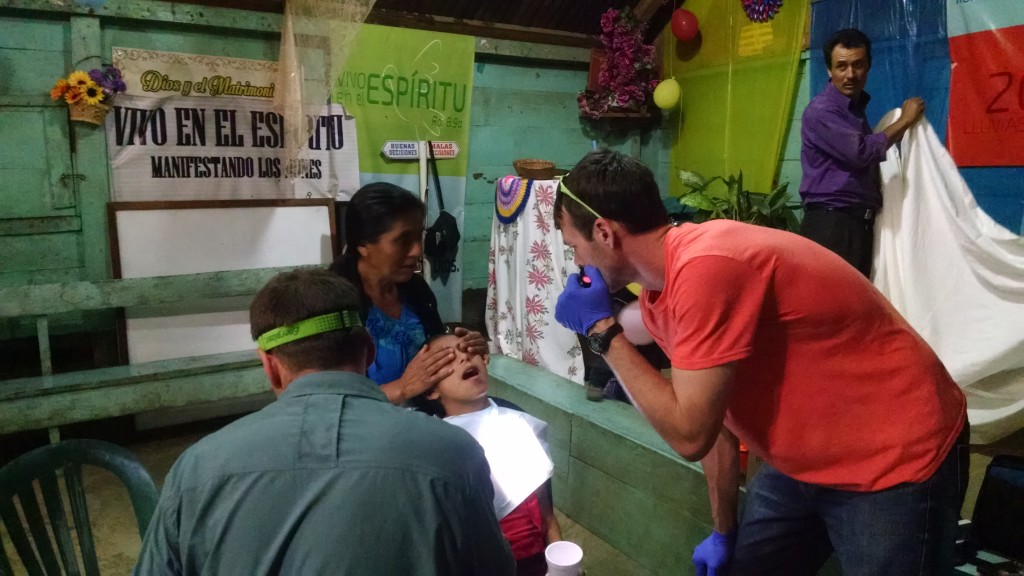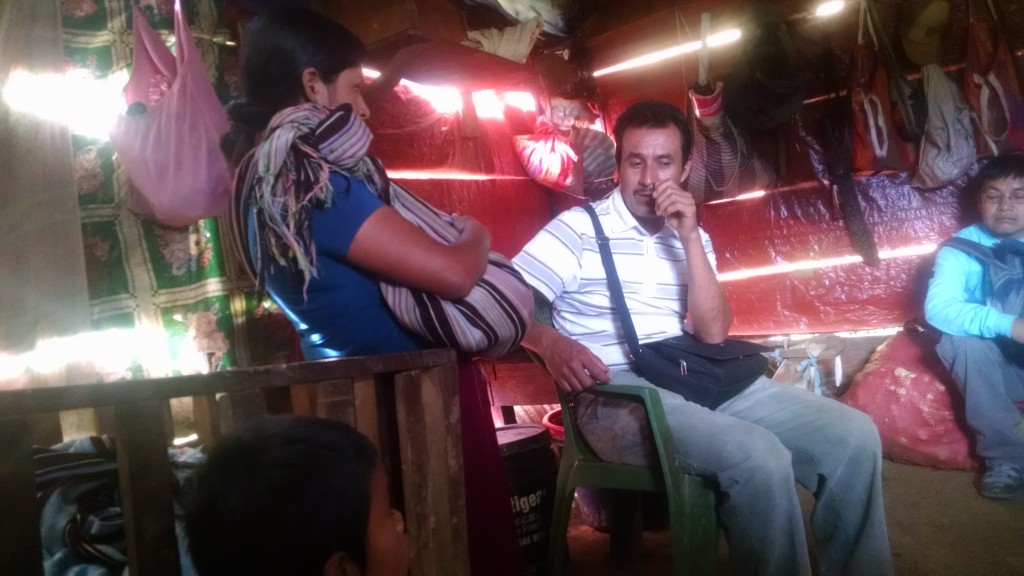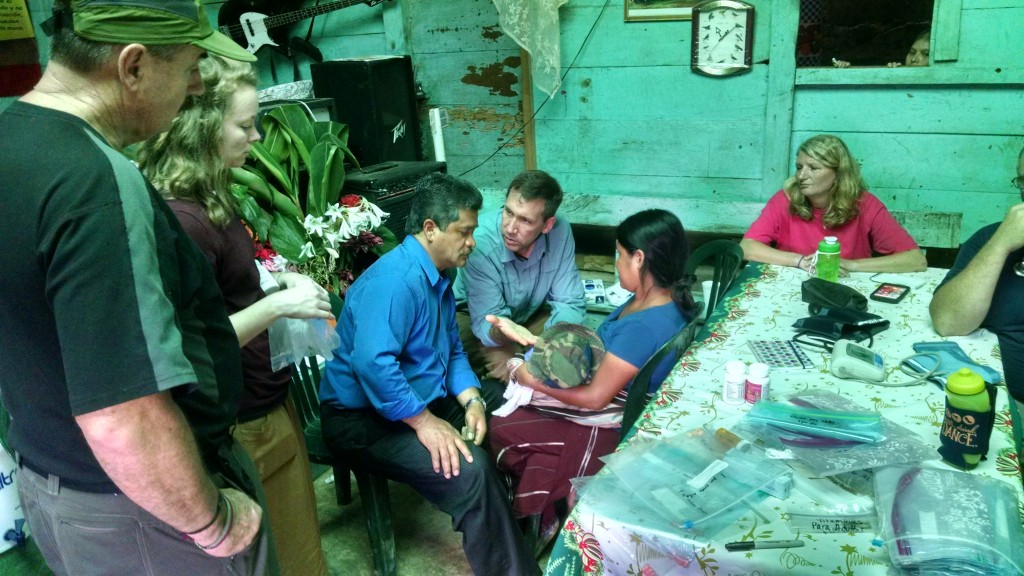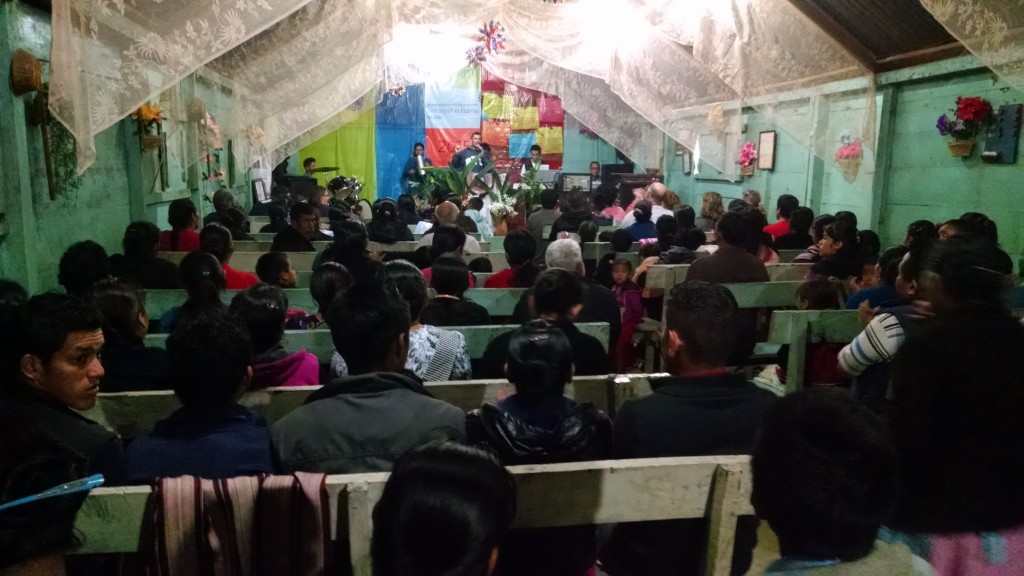Today we’re not talking about HR.

Helping with the dental work
I’ve been quite of late, because it’s difficult to write from a remote village without electricity. From the end of December to early January, I returned to Guatemala for a mission trip designed to encourage and uplift some of the poorest people on earth (materially speaking). Below you’ll find a report based on my experience. I write this recollection not to “show off,” but to help keep myself focused on the most important things in life, such as faith and family.
I hope that this story gives you some hope yourself and possibly even encourages you to look for an opportunity to love on someone else, whether they are nine thousand miles away or just nine feet away.
I visited Guatemala two years ago on a similar trip and knew that I would one day return. I told my wife that I wouldn’t go back until she was able to experience it herself, and in July 2015 she joined a team visiting San Pedro Las Huertas in Sacatepecquez. It was a wonderful time for her, and it allowed me to make good on my promise to return. For the past few years, both of us have worked on the planning team for our church’s annual auction to support two feeding centers in San Pedro Las Huertas and San Cristobal el Bajo. Each feeds more than a hundred kids a day, which for most of the kids is the only meal they will get all day. Melanie was able to see the feeding centers in operation when she visited, which was probably a humbling feeling to see all of that effort paying off. Unfortunately the feeding centers were closed for the holidays while I was there (apparently Guatemala follows the United States’ lead and pretty much shuts down between Christmas and New Year’s).
There were many facets to trip preparation. It’s not as simple as packing a suitcase and heading for the airport. We were bringing 250+ stockings full of toys, clothing and personal hygiene items to pass out for kids, plus we had to plan for daily bible school lessons and more.
Sunday
I’ll just mention here that I hate being away from my family for any length of time. When I decide to go on a trip, that’s usually the first hang up I have. But I had committed to this experience, so…
Sunday afternoon one of my team members and I took all of the stockings and luggage to Atlanta to save some time and simplify logistics for the team. One extra night away, but it saved us from having to be up at 2:30am to get on the road in time for the flight.
Monday
Monday morning we met the rest of the team at the airport and hopped on the plane. Guatemala City, here we come! Coming back was very much a reunion-like experience for me. I had many friends in San Pedro las Huertas from my previous visit, and it was a great chance for me to practice my rusty Spanish yet again. On the way to the mission house from the airport, I rode in the only truck without an interpreter and was able to have a good conversation with our driver, which was fun.
That night we ate dinner and repacked the vehicles with plans to leave first thing in the morning.
Tuesday
The team was very excited about the trip, despite being on the road for nine hours. We did last minute checks and hit the road. At Chimaltenango we picked up our third driver, Pastor Luis. This man has been visiting the people of La Perla for a year at monthly intervals, and he was our local connection to the community there.
Again, I ended up riding in his vehicle with the rest of the gringos that didn’t speak a lick of Spanish. You never realize how much you talk on a nine hour road trip until you’re riding with a driver that doesn’t speak English.
The trip, though long, was fairly uneventful. We stopped for lunch at one of the only Gringo-safe places, Pollo Campero, in Santa Cruz (Quiche) and then continued on our way. We arrived late in the afternoon just before dark. There was just time for a quick dinner before we had church service. After that we all hit the hay, tired from the long day’s events.
Wednesday

House visits with Pastor Julio
The plan for the day included house visits for church members and family in the morning and vacation bible school for the kids in the afternoon.
I had the amazing opportunity to go for a run at first light, seeing the sleepy little village coming to life one cooking fire at a time. I’ll admit that I got some funny looks from the locals, but everyone was friendly and it is a memory I’ll treasure.
During our house visits, we had our first run in with the biting flies of La Perla. These small, gnat-looking bugs drink blood like a mosquito, but they don’t alert you to their presence since they are very small. But lunchtime some of the team had more than a dozen bites on their faces and arms. (I’d like to send a personal thank you to Off! Deep Woods for their support of my trip). :-)
One of the families we visited had recently lost someone, and that was definitely a pull at the heartstrings. However, the second visit was one I want to cover in more detail. We checked in on a Mayan family living on the side of a hill. They were quite poor, even by local standards. They had a dirt floor and a fire going in the middle of the room for cooking and heat. As soon as we walked in, the lady’s daughter ran to a neighbor’s house to bring chairs so that we could sit. As soon as we all were seated, she went and retrieved all of her food and began passing it out to us, a set of complete strangers. This amazed me, and we weren’t able to refuse it, because it would have been an insult to her and her family.
At bible school we did a lesson on Daniel and the lion’s den and did a little lion craft with the kids. Some of them were very shy, because they had never colored anything before. Then we played games–one of the team brought a massive bubble wand and made bubbles 2-3 feet long for the kids, and they were thrilled.
Thursday
The plan for the day included house visits for church members and family in the morning and vacation bible school for the kids in the afternoon.
The house visits on Thursday really got me. We hiked up the trail on the side of a mountain to get to the homes. At one home we met a teenage girl with no legs. Every night her little sister carries a flashlight and helps her get down to church, more than half a mile away. This girl crawls there every night. I was completely blown away by her faith and dedication.
We started to get a bit tired down from the kids being around us at every moment of the day, plus not getting much sleep at night. The children were climbing in the windows of our rooms, trying to see the gifts that we had brought for them. :-)
Friday
The plan for the day included a medical clinic in the morning and vacation bible school plus stocking distribution in the afternoon.

Discussing care of a very sick baby with his mother
The local church had handed out fifty numbers for patients for the clinic, but through various conversations another twenty five people had been invited to come for treatment. We had a pretty good setup going. One team working blood pressure (note: even seventy year olds had great blood pressure there thanks to walking everywhere on mountain trails!), two dispensing medicine, one person diagnosing patients, some praying with the patients, and others working however they could. Because I have some understanding of Spanish I was writing instructions on the medicine as we prescribed it to patients.
Nearly everyone we saw had worms or parasites simply because their water is full of bacteria and germs, they don’t understand how to cook food properly, etc. I believe the long term answer to this is education, but as of today we wiped out a considerable number of parasites with the medication we distributed.
Some of the most heart-breaking stories, from the man that hadn’t eaten in fifteen days to the baby that wasn’t getting enough nutrition and might not survive, happened during this clinic. On one hand it was great to help ease the suffering of these people, but on the other it reminds me just how much pain there is in the world.
There were two kids that needed teeth pulled, and I was able to help a bit for the second one. The girl’s tooth had rotted, and grabbing it made it crumble to pieces. After several unsuccessful attempts we decided to bring her with us on the return trip to the first large city, Navaj, to see a real dentist and get the tooth pulled for good.
Due to the number of people at the clinic, we just had time for a quick grab and go lunch before bible school started. We did our lesson, took the kids out to play, and then brought everyone back into the church and locked the doors. We knew that this would be a problem if kids were wandering by and saw the gifts coming out, and we didn’t have enough to offer everyone in the entire village. We had brought approximately 250 stockings, and Pastor Luis brought about 50 more small gifts as well.
Once the kids were in the church, we told them they would get a single gift and then would be sent out the door. It was my job to guard the door and prevent anyone else from entering, because the priority was to serve the kids who had attended bible school. That was heart-wrenching, because within five minutes of these kids streaming out of the church with gifts, there were more than fifty people outside trying to get in and secure a gift for themselves or for their children. In the end we let a few more in and handed out everything we had, and we had to be comfortable with that. Just like with the medical clinic, you can’t help everyone, and that is just part of life.

The church was packed every night. Standing room only in the back.
That night we treated the locals. During church service every night they ran a generator to power the lights and audio equipment. We brought a projector and DVD player and the movie War Room. Most of the people there had never seen a movie before, and I knew it would be an experience. The entire church was packed out, standing room only, and the back walls were opened up so people could stand outside and still see. In the two hour movie, people sat on hard wooden benches and drank in the experience. The movie has a powerful message, and it was evident in the tears that shone when the lights came up at the end. I don’t think they will soon forget it.
Saturday
Saturday morning was bittersweet. We were excited to go back to the mission house in San Pedro and reunite with our team, but we were also very sad to leave the wonderful people of La Perla. We brought the little girl and her mom with us to go the dentist in Navaj, and that proved to be a painful experience. The girl’s mother did not travel often, so she got motion sickness and would not take any medication offered by the team. She ended up throwing up four times in the back seat of the truck, turning the three hour drive into a five hour drive. Once we got the girl in to see a dentist and off on the bus back home, we continued our journey. Ultimately with traffic and the other issues, we ended up taking thirteen hours to get back to the mission house.
Everyone was very tired from the road trip, but the nearby volcano was sending up lava on and off all night, and most of the team stayed up to see the eruptions.
Sunday
Sunday morning we had church in San Pedro. I rode with Danny, the local missionary, to pick up kids and families for church. It was great to see some of the same kids I remembered from before.
After church, one of the kids was left behind, so a friend and I decided to walk him home. After we dropped him off, I realized we were at the same location where we had built a house on our previous visit. I remembered hearing Danny say that the mother/wife had just died a few weeks prior of appendicitis at the age of 38. Despite me only having a grasp of the basics of Spanish and the family not speaking any English, we stopped by to offer our condolences. After all, on the previous trip we had played with their kids and spent several days building their home from the ground up, so we felt like we knew them as well as anyone else.
Sunday afternoon we began packing our gear for the trip home. It had been a long week, and we had accomplished much in the relatively short time we were in Guatemala. Monday morning we went to the airport and flew back to Atlanta.
Looking back now, it seems like it was all too short of a trip. I’m extremely blessed to have had the opportunity to visit with and love on these amazing people. My team was phenomenal. And my wife is a saint for keeping up with our kids while I was out of town. All that said, it was the wonderful experience that I hoped and prayed for.




 This was a painful process, but it usually yielded fairly good results. I think that many of us try to do the same with this big data/analytics concept. We immediately go out and
This was a painful process, but it usually yielded fairly good results. I think that many of us try to do the same with this big data/analytics concept. We immediately go out and  Let's say I walk up to you and hold out a piece of cake wordlessly. When the next person comes by, I hold out the same type of cake in the same way, but I smile and say, “Hello!†cheerfully.
Let's say I walk up to you and hold out a piece of cake wordlessly. When the next person comes by, I hold out the same type of cake in the same way, but I smile and say, “Hello!†cheerfully.